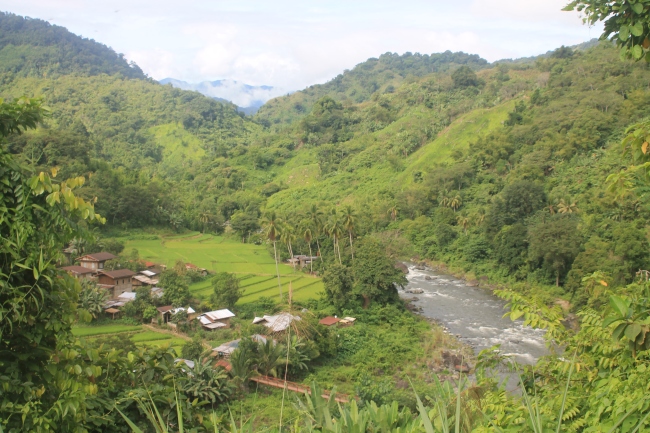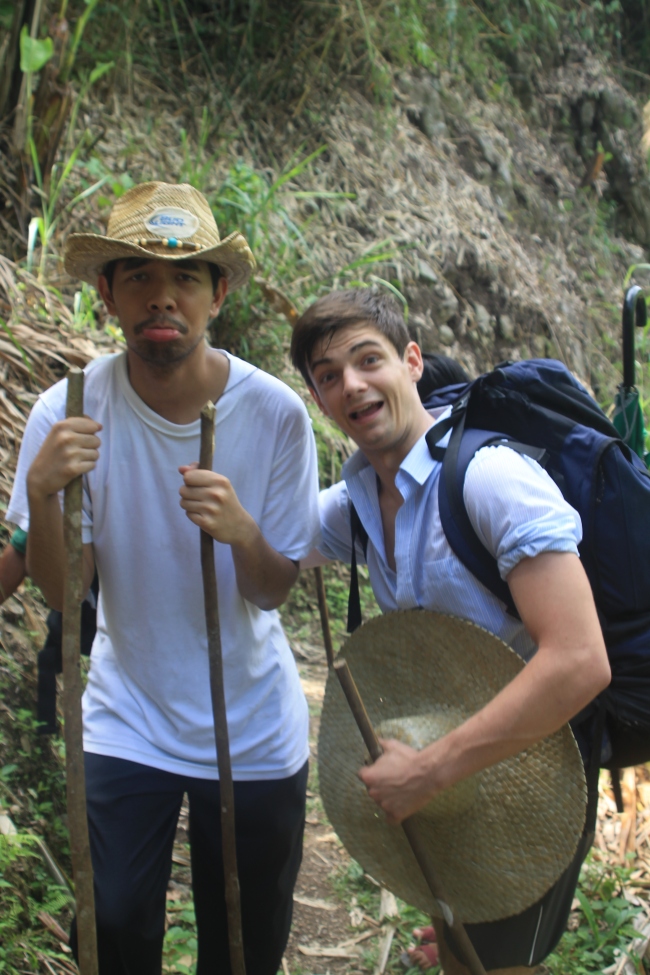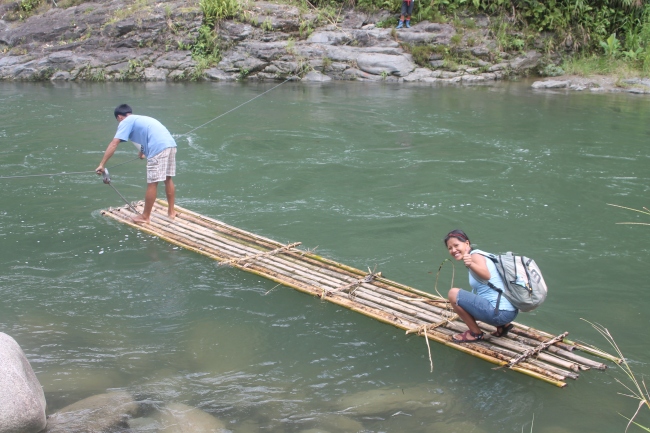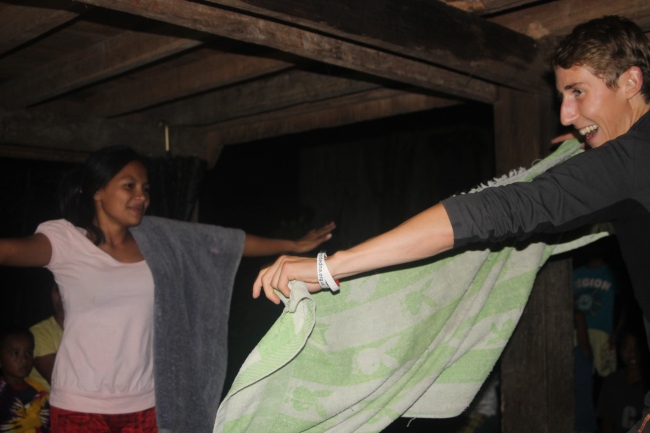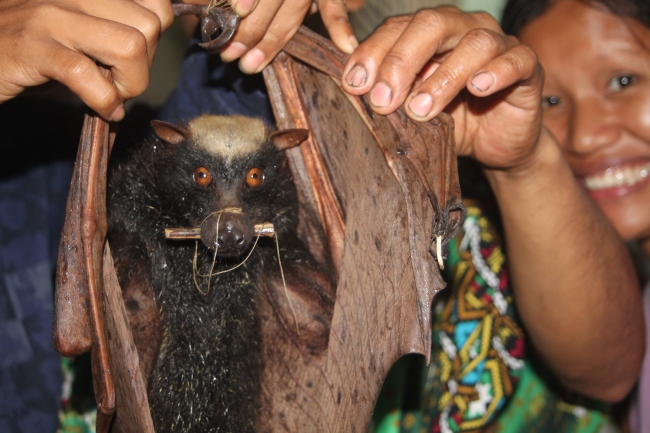Imagine you are driving down the motorway at 70mph (112km/h), and you stick your head out of the window. What kind of force would you feel? You’d be mad to do it. Now imagine that the air is thick with debris, bits of tree, corrugated iron, pretty much anything you might find in your house. Pretty shit scary huh? Yolandas winds gusted up to 275km/h – 2.5x faster than motorway speed, and had all manners of crap flying through the air.
Typhoon Yolanda blasted through the Philippines 8 months ago, killing over 6000 people, roughly 2500 of which perished in the regional capital, Tacloban. I remember CNN anchor Anderson Cooper talking of the terrible stench of death pervading all areas of the town, and bodies were still being found three months later.
Last week, I landed in Tacloban to visit some rural sites that had been affected by the typhoon. The airport was scrappy, but not obliterated. Outside the airport, there is a camp of UN Humanitarian Crisis Response tents. We would see a lot of these tents as we drove around the coast to Guiuan – where we boarded a boat to Manikani Island.

You can see how the geography funnelled the water towards Tacloban, resulting in deadly storm surge. We were on Manikani Island, just off Guiuan. Map via reliefweb
Tacloban was a bit messy, but not too bad. Our driver Henry told me that the storm surge had pushed the water up to the second story on buildings near the coast, so while not a technical tsunami, there was a similar effect. I was terrified at such a proposal – deep water and ridiculous winds. There were some gutted large concrete buildings, but otherwise there didn’t appear to be that much damage. The clue, however, was in the prevalence of wooden buildings, the type that you don’t normally see in a city. My guess is that where peoples concreted homes had been destroyed, unable to afford stronger materials, they had rebuilt with wood and tarpaulin. My big fear now for the region is that these “temporary” structures become “permanent”, what will happen in the inevitable next typhoon?

This was Tacloban 8 months ago. Notice the concrete rubble. Photo via tempo.com.ph
We drove for about 3 hours round to Guiuan. I took a lot of photos out of the window, amazed at the scenes flying by. To borrow from a Clowns Without Borders (yes it’s a thing and they do fantastic work) blogpost “it looked like God took a machete and lopped off every palm leaf”. UNHCR tents and tarpaulins donated from USAID and IOM (International Organisation of Migration) serving as roofing were present wherever there were people. One thing I noticed in a lot of places were the words “SOS” or “HELP” painted in big letters on road surfaces, desperate appeals to helicopters from the instant aftermath. Thankfully, the paint is now fading along with the urgency.

The town looked OK now, but this remained as reminder of darker days. I saw this sign too late to take a photo, so I’m borrowing this image from clownswithoutborders.org
Some time later we were on the calm sea over to Manikani Island. A small island home to around 4000 people, two thirds of all buildings were completely destroyed in Yolanda, the rest only deemed “reusable”. I want to reiterate what I mean by completely destroyed, as stats can become meaningless. Completely destroyed means that there is no part of house left standing, the only thing that is left is the floor, and this was to two out of three buildings. Just unbelievable (Jeff). Thanks to a well organised evacuation to higher ground, only one person died on the island, but it took a week for any external aid to arrive, leaving the residents hungry and without shelter during that time.
Interesting aside: Homonhon Island, next door to Manikani was the first place that Magellan landed in the Philippines. He was later killed by Lapu Lapu in Mactan province.
The SIBAT team – Jeda, Rodel, Fergus and myself were there to carry out “Pre Feasibility Studies”. That is, it is the first time that anyone from SIBAT has visited the area to find out what the people want and need, and what infrastructure remains that we can build upon. Given that the disaster and danger had long since passed, and scars had mostly healed, I was able to enjoy the expeditionary nature of this trip. Furthermore, it was a fact finding mission with a clean slate, a trip funded without an agenda – simply to go there and find out what we can do to help.
Our home for the week was one of the UNHCR tents we had seen so many of. Tita (Auntie) Vicky’s family had built a modest wooden house to replace their concrete home that had been bulldozed by the wind, the rubble scattered on the ground around the tent to provide drainage. The storm surge had only brought water up to the knee level – so this was pure wind damage. I mean seriously – what kind of evil can blow down a concrete home!?? Big bad wolf Yolanda that’s who.

This is the kitchen and the dining room. It was actually a thoroughly pleasant place to eat and hang out. Not sure how it will cope come rainy season.

Here is the rebuilt wooden house, and the guest tent, which stands on the base where the living room was.
During the week we would go and visit one of the four barangays (villages) and hold a meeting about what the people want and need. These meetings variously took place in a bombed out church, a church made from tarpaulin and just sitting in the road. I would surprise people at the start by introducing myself and SIBAT in Tagalog, having improved much since Mr Tanayan chewed me out a few months ago in Looc. I even got a few rounds of applause! Jeda or Rodel would then run the meeting, leading the discussion to find out what was important to the people.

The town square in Buenavista. Notice the word HELP in 10ft letters, and the devastated church where we held our meeting.
Manikani isn’t currently connected to the grid, but it will be soon. This is good but as the Philippines has the highest electricity prices in Asia (relative to average income), there may be scope for solar panels to reduce the cost on residents, but all in they and we were much more interested in water sources.
The next step was to assess the water sources. A few years ago, there had been an Australian Aid project to provide solar powered water pumping to each barangay, and it was very successful, until Yolanda came along and knocked its socks off. At every site, there was a 6m water tower sans tank, and topped with twisted steel. The tank and solar panels were simply gone. Some sites also had access to a spring up on the hill. We assessed all the sources for bacteria – most of them failed – and took various measurements. We had a happy time trying to work out the flow and hydraulic head from the spring source – soaking Rodel in the process.
Outside of working hours, we would swim in the warm sea, read and relax, play cards and one afternoon I was force fed gin and had to go to bed at 5pm. I tried my hand at basketball – total flop.
For me this was probably the best site visit I’ve done, mainly due to the family we were staying with. Tita Vicky had a pretty 19 year old daughter called Iris, and a 24 year old son called Ivan. They all spoke very good English so it was easy to bond with them. I asked Iris about her experience during the typhoon. I can’t remember the exact words but here’s the gist:
“I was studying in Guiuan when the typhoon hit. My cousin and I hid under the table as the walls caved in around us. When the water started rising we ran to my grandmothers house on higher ground – it was very difficult due to the strong wind. We saw some mangoes on the road and grabbed them! We were hungry! After the typhoon it was very hot, but we needed to repair the house. It would rain at night – so for three days we tried to build a shelter where the house had been but we were sleeping under umbrellas and wearing the same clothes every day. I don’t know why but I wasn’t worried about my mum in Manikani – when I got back, I asked her “Where’s the house?!””
On a bus I asked an English teacher who lived closer to Tacloban about her experience:
“We had about 7 families who came to shelter in our house because in was stronger than theirs, so it was very crowded. The house stood up to the wind, but when the water level rose, my husband ordered everyone outside and onto the higher ground behind the house. While we were running my brother was hit by a falling coconut tree. It split his head open and dislocated his shoulder. We wrapped it up but he wasn’t able to get any proper treatment until 4 days later. He can’t work anymore. The water continued to rise and it was up to my midriff. My daughter had a poisonous snake in her dress and we had to tell her to be very still so we could remove it. We watched as the house was destroyed and carried off – everything we owned, all the furniture, our TV, but I was most upset about the photographs. Our old house had six concrete pillars, but when we can afford to rebuild, we will have nine!”
There are 12 million stories like these. That’s about the same as the population of Belgium.
We also visited another site on the mainland, where a bunch of hippies had moved in and had done some good work building a shelter and a permaculture vegetable garden. It was all very nice, but it did seem to be missing the point somewhat. The “guitar library” would bring some joy to the kids, but I was reminded of Maslows hierarchy of needs, and at present, the people in this village don’t have access to any source of potable water. This led me to my quote of the week
“The problem with these artsy types is they massively underestimate the importance of infrastructure”.
At least I know I was always destined to be an engineer.
I took a ton of photographs and have uploaded most of them to my google picassa page. You can see them here: https://plus.google.com/u/0/photos/106608639711482833981/albums












































